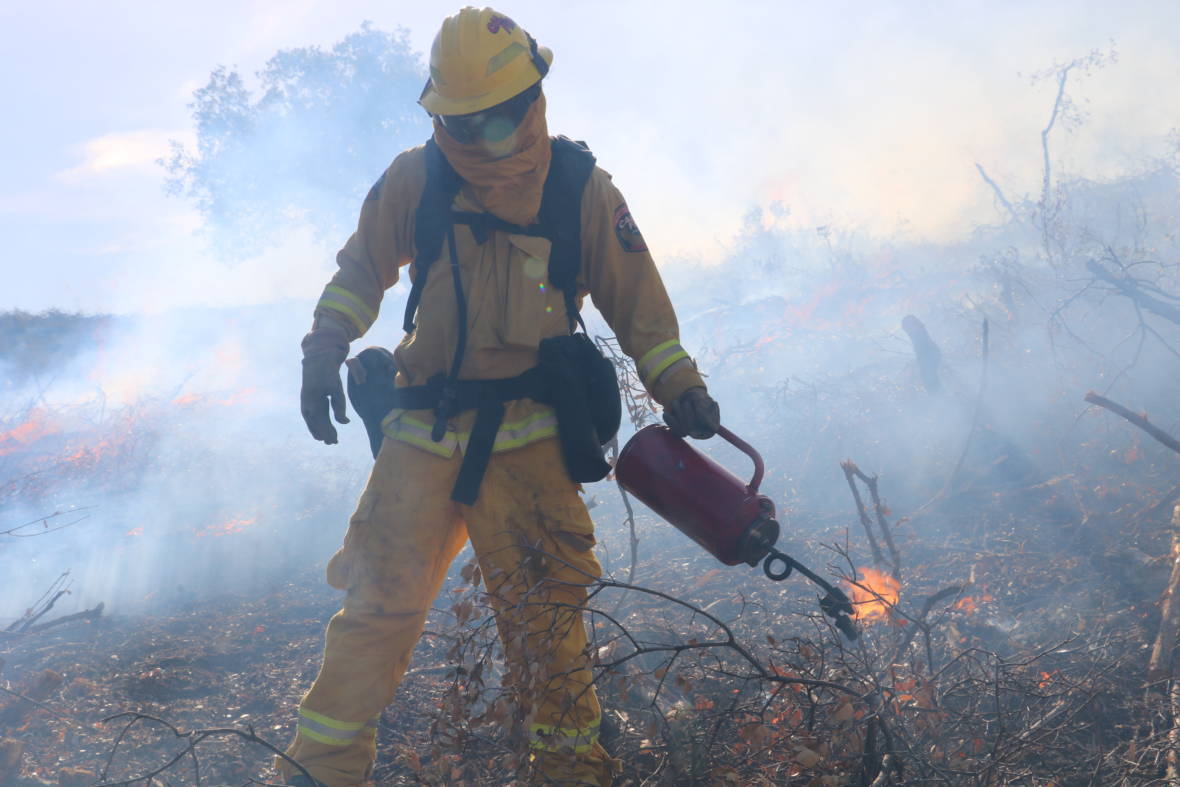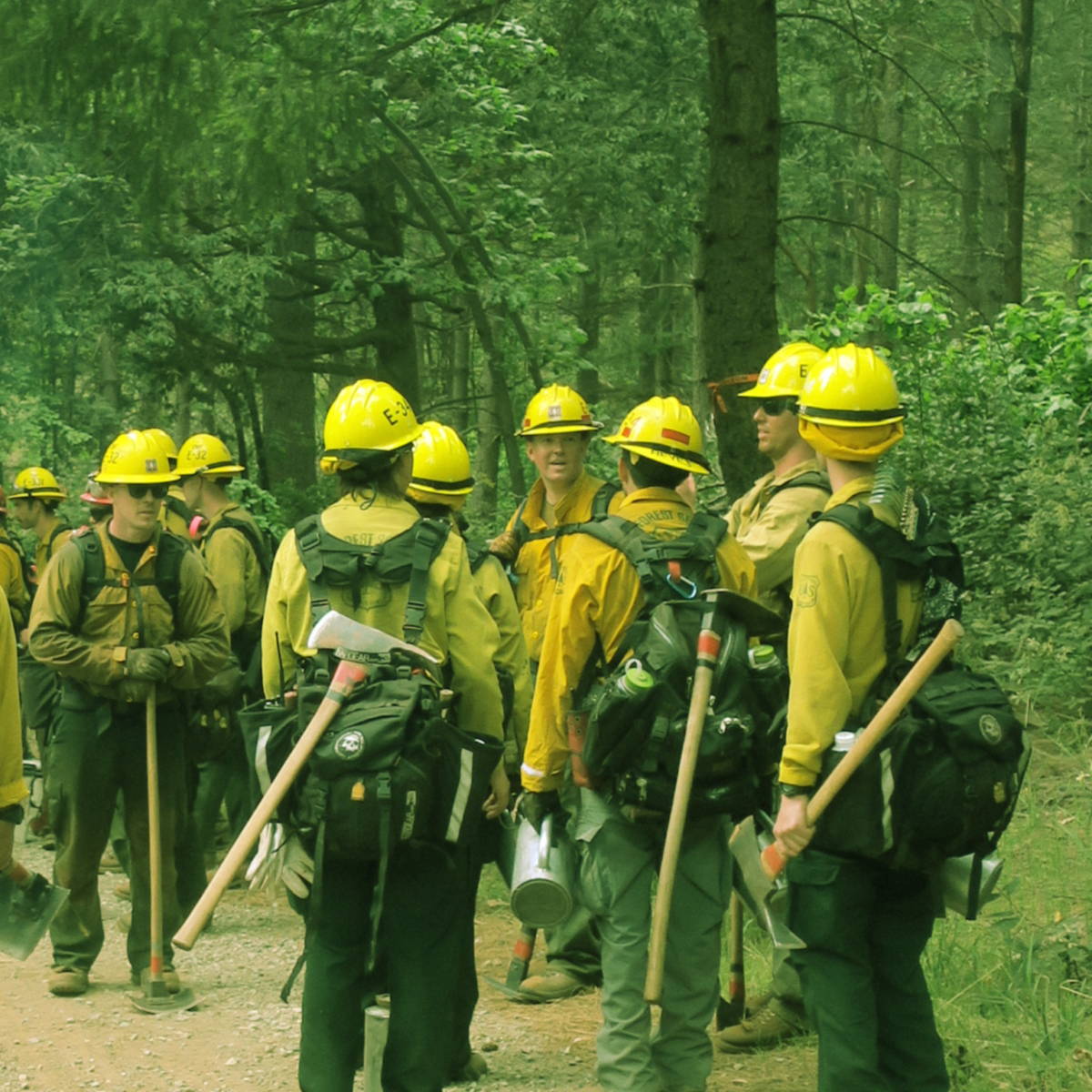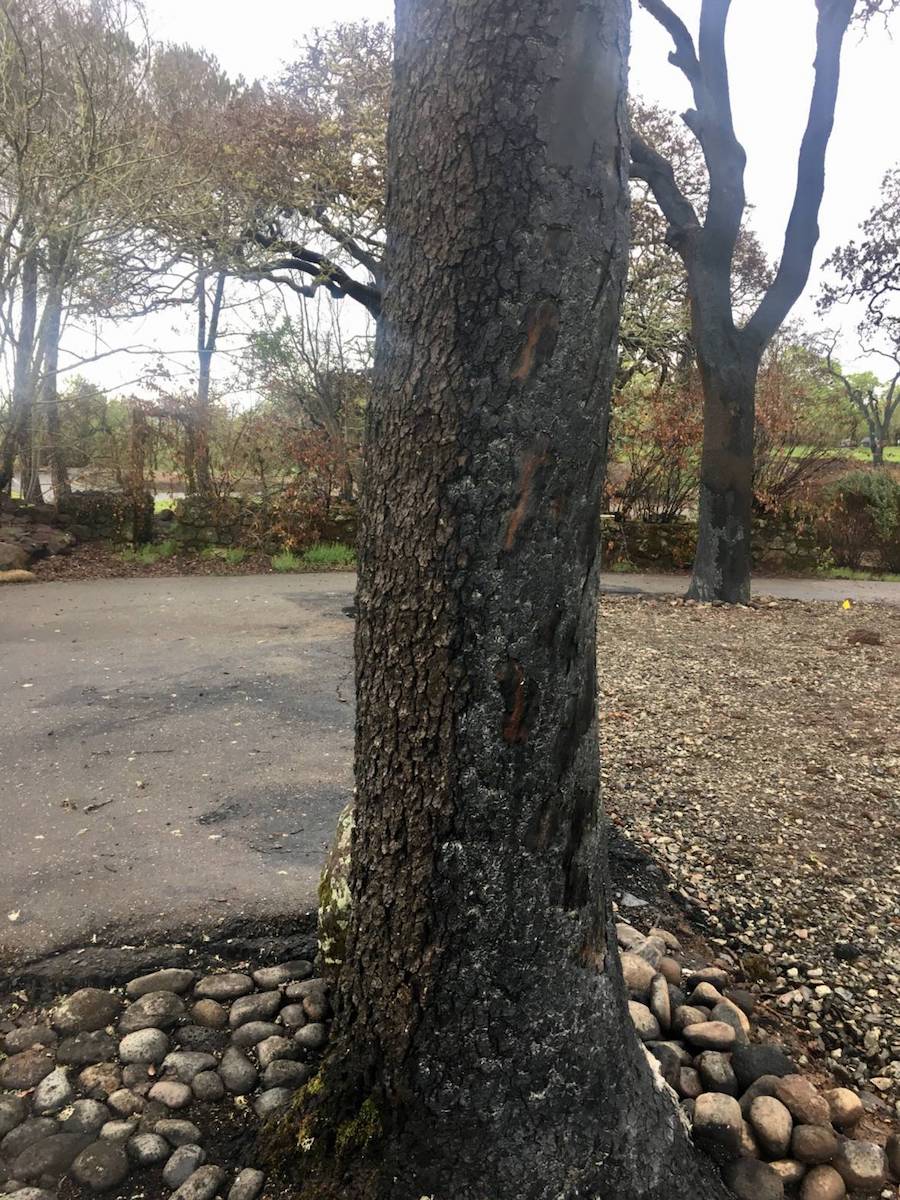Can California Use More Planned Burns To Prevent Catastrophic Wildfires?
5:26 minutes

 This segment is part of The State of Science, a series featuring science stories from public radio stations across the United States. A version of this story, by Molly Peterson, originally appeared on KQED Science in San Francisco.
This segment is part of The State of Science, a series featuring science stories from public radio stations across the United States. A version of this story, by Molly Peterson, originally appeared on KQED Science in San Francisco.
With climate change, wildfires threaten disaster and chaos in more California communities, more often. But experts say it’s possible to avoid catastrophic harm to human and forest health by setting planned burns before human error, lightning or arson choose when fires start.
“Putting prescribed fire back out on the landscape at a pace and scale to get real work done and to actually make a difference is a high priority,” says Cal Fire chief Ken Pimlott. “It really is, and it’s going to take a lot of effort.”
In a February report, the watchdog Little Hoover Commission concluded that the way California landowners have collectively managed forests is an “unprecedented catastrophe.” In May, Gov. Jerry Brown issued an executive order to improve forest management, and with it, a dramatic change.
Now Pimlott says that Cal Fire intends to triple the amount of prescribed fire on lands the state controls.
“We can prevent these large catastrophic fires or at least reduce the intensity when fires do occur,” he says. “So a little bit of smoke now and a little bit of inconvenience now is well worth offsetting these large damaging fires.”
That’s a small step toward addressing a major deficit. According to the commission’s report, an area the size of Maryland—including state, private and federal land—needs maintenance or planned fire to become healthier.
One day of prescribed burning in the Tahoe National Forest offers a glimpse of the difficulties in completing these projects.
U.S. Forest Service wildland firefighters hacked a line into the earth, around a patch of land on the Yuba River District near Pendola, overlooking Bullard’s Bar for one day of work. A “hot shot” crew and crew members from two engine companies gathered for the day’s work.

“This day started a few years back,” Jennifer Hinckley laughs dryly. Hinckley is a fire and fuels specialist for the Tahoe National Forest. And she does a lot of paperwork: before the first torch even can drip fire on the ground, federal law requires extensive environmental review.
Even with approval, federal wildland managers waited months for the right weather and environmental conditions here. Hinckley says those criteria range from wind speed and temperature, to how much water is in the soil. It was a very wet spring; on-and-off rains created several months of delay here.
Thick vegetation in the understory is a limiting factor, too. Hinckley says her crews often need to chop and flatten vegetation to make safe conditions for burning.
Even when all of the stars align, Hinckley says she might not have warm bodies for the job. That happened last fall, when fires up and down the state kept fire crews hamstrung.
“I didn’t have crews to perform prescribed burns,” she says, “because the wildfires take priority.”
Even when the permit is done and the weather is right and crews are available, the air might already be too polluted to add more smoke to the mix. Air regulators grant permission for burn days, and it’s hard to get: regional atmospheric conditions mean that smoke from Sierra Nevada forests funnels toward the central valley, where air pollution is consistently bad.
Whether from wildfire or planned burn, smoke feels like pollution to vulnerable lungs.
“The consequences are the same in terms of patient response,” says Fresno-based asthma and allergy specialist Praveen Budigga. “I mean, patients are going to have the same effects of the fire.”
State and regional air boards say they’re working to balance forest and human health.
“We have to protect public health; that’s our mandate,” says Dar Mims, a meteorologist with the California Air Resources Board. “But we also recognize that we need burning in the forest, and a lot of those trade-offs have to happen in real time because the decisions have to be made—do we want to potentially impact the air basin, or do we want to burn.”
Air regulators and fire officials say that to promote prescribed burns will require better public education about their relative hazards. Last year, a groundbreaking study concluded that wildfire smoke contains three times as much pollution as smoke from prescribed fires.
“We have to protect public health; that’s our mandate.”
CalFire’s Ken Pimlott says that’s reason to push for more burn days.
“We want the ability to have some more flexibility to be able to burn on days [when] maybe it’s not quite as close to an air quality attainment day as one would like but it’s a perfect prescription window,” he says. “Say we have the resources available and the temperatures and humidities and wind—all of those, vegetation, are all in alignment to make a perfect burn and so we want the ability have a little flexibility.”

Evidence of the ecological benefits of fire are visible at the Bouverie Preserve, a wildland area in Sonoma County. Beginning in spring, a living carpet of purple lupine, white popcornflower, yellow fiddleneck unrolled across the preserve’s fields and canyons.
“It’s lush and green with wildflowers. It’s pretty beautiful,” says fire ecologist Sasha Berleman. To her, this off-the-charts growth signals a healthy landscape, where wildflowers followed the fire in short order.
But look closer at the trees, she says, pointing out how the heat of the Nuns fire blackened the ground and charred the oaks, their trunks scarred with flames up to six feet high. Berleman wonders whether the fire needed to be that severe.
“With that wind event that we had, it’s not that this fire is completely preventable but we could have probably had an impact on the behavior of the fire within the area that burned,” she reflects.
To see how, she points across the path, to a 17.5-acre plot where she lit a prescribed fire last May. Those trees remained green. Flames were only inches high. These lands will recover faster.
“They might have not burned so hot or so extreme in the oak woodlands if we had been managing them on a regular basis,” Berleman says.

She also thinks more planned burns could have saved Bouverie’s buildings. That hot and extreme fire torched all but one of them. Berleman went back to the preserve as the fire raged. She and two men were able to save that last building, David Bouverie’s own, using a bucket, a shovel and a chain.
“So now that building has a special place in my heart,” she laughs. “We spent a good 24 hours together.”
Berleman now works as a consultant, promoting the use of ecologically applied fire for private clients and the East Bay Regional Park District, among others. Paradoxically this summer, she’s deploying her “hot shot” training as a wildland firefighter, where the job is to stamp fires out.
“I felt like we’re sometimes putting out fires that were doing good work. Just because that’s what the machine does,” Berleman says. “That’s what we do, put out fires.”
Her hope is to reconcile the conflicting aims of these jobs, and the relationship between fire and California’s landscape, to get scientists and wildland managers heading in the same direction.
Craig Thomas, conservation director for the Sierra Forest Legacy, says in the last 25 years, that’s become easier to do. But during those years, Thomas points out a different challenge has been growing: more people have moved into wildlands from cities.
“There is a, you know, thinking that a landscape is like a photograph,” he says ruefully. “You know, when you have these big beautiful trees and we want to freeze-frame them.”
Thomas argues that’s a bad idea. Fire is a natural disturbance, he says, “a process that is every bit as much of the picture of where you land as the trees are.”
For him, the forests are a movie, not a picture. Trees have a starring role, but so does fire. And it doesn’t have to be the bad guy in a summer blockbuster.
Molly Peterson is a science and environmental reporter at KQED in Los Angeles, California.
IRA FLATOW: Now it’s time to check in on the state of science.
[MUSIC PLAYING]
SPEAKER 2: This is KER–
SPEAKER 3: WWNO.
SPEAKER 4: St. Louis Public Radio.
SPEAKER 5: Iowa Public Radio News.
IRA FLATOW: Local science stories of national significance. You know, the fires in California now are the deadliest and most destructive to hit that state, with more than 10,000 structures destroyed, scores of deaths, even more missing. And you know, we’ve often heard that burning before these big fires can help prevent these out of control wildfires. You clear out all that flammable brush.
And back in May, California Governor Jerry Brown put out an executive order that doubled the amount of land that could be managed by these prescribed fires and other forest management strategies. So is it getting done? Molly Peterson is here to fill us in. She’s a reporter for KQED Science based out of Los Angeles. Welcome to Science Friday.
MOLLY PETERSON: Thank you.
IRA FLATOW: So Governor Brown put out that executive order in May. What did it do to address the fire prevention?
MOLLY PETERSON: Well, when you talk about doubling the amount of land managed against fire, burning is just one part of it. Vegetation management and reforestation were really the bulk of it. And the idea was to double the amount of land to about half a million acres that would be managed this way. That executive order also was kind of the governor laying the foundation for adding $100 million to the state’s budget for this kind of activity.
According to a state watchdog commission, though, we need an area the size of Maryland– about six million acres– to burn in prescribed burns to sort of improve conditions to where we’d like to see them better.
IRA FLATOW: So you need a lot more going on is what you’re saying?
MOLLY PETERSON: Yeah.
IRA FLATOW: Yeah. And that’s expensive and takes manpower, and you have to plan for all of that.
MOLLY PETERSON: Yeah. I mean, there’s the environmental review problem– making sure that once you do that you’ve got the temperature, the wind speed, the direction of the wind, the soil moisture, the speed by which the brush will burn. And in a lot of cases, you need to mechanically thin these lands that haven’t been managed as we’ve suppressed fires and kind of kept off of these lands.
IRA FLATOW: So there are a lot of factors that need to be considered when setting one of these controlled burns.
MOLLY PETERSON: And I didn’t even mention the air quality, right? Yeah.
IRA FLATOW: What do you mean the air quality?
MOLLY PETERSON: Well, I mean, in the Bay Area right now, there’s measurements for particulate matter. And that’s south of where the fires are burning in northern California. There’s measurements for particulate matter five times what we have in Los Angeles on a bad day here because there’s an inversion layer over the greater Bay Area kind of holding that smoke in. Uncontrolled fires are responsible for something like 50 million metric tons of pollution at least a year in California. That’s up to a sixth of our state’s overall emissions.
IRA FLATOW: You talked to CAL FIRE, the department that’s in charge of fire prevention. How do they plan on expanding these prescribed fires? What do they need for this to happen?
MOLLY PETERSON: Yeah. When I talked to Ken Pimlott back in the spring, he was saying– by the way, at the time, he was saying that they needed to stay out of trouble on mega fires in order to really transition to this world where they can do these prescribed burns. The idea is to sort of establish teams that are ready at all times for the purpose of prescribed burning, but that’s hard to do when you’ve got to deploy all these guys to various fires that are burning around the state.
And at the time, he was saying, look, we have a problem. The grass– if you’re a firefighter, you call it flash. It looked flashy because of drought. So this isn’t a forest fire problem entirely. It’s also this dry grasslands that burns quickly as well.
IRA FLATOW: And sure, these fires are happening on a mix of land. You have private. You have state. You have federal areas. How do you coordinate all of that?
MOLLY PETERSON: I mean, I think these guys go to lots of meetings together.
IRA FLATOW: Sounds very difficult
MOLLY PETERSON: Yeah. Yeah. I mean, I think there’s a lot of meetings. You’re right. The federal government controls something like 46% of California’s land. There’s also a lot of interest in private land, particularly in the northern part of the state– not just in more burning days, but also in logging for thinning purposes is something some conservative lawmakers have been pushing as well.
IRA FLATOW: Does climate change fit in here? How does that fit– does that fit into this picture?
MOLLY PETERSON: I mean, this is one of those ones where sometimes people want to make it sound like it’s all one thing or an all one another thing, and it’s not. Climate change is a part of what’s happening here, but it’s a fallacy that, frankly, the President played into with his tweet– that it’s all one thing or another.
There’s also huge amounts of planning that needs to be done to get areas around the wildland-urban interface into some sort of a code that’s responsible about how people develop on those lands. The management, the vegetation stuff, that’s just how we’ve budgeted for decades in California. That has nothing to do with climate change. So there’s a lot of causes for the problem were in and no easy way out.
IRA FLATOW: Molly Peterson, reporter for KQED Science. We’re going to take a break and talk more about our wildfires. It’s going to continue our coverage at least, and as we talk about how to protect housing developments in high fire-risk areas and how we can strengthen the electrical grid to prevent sparking future fires. There’s some speculation that there might be a spark that has set off some of these fires.
We’ll be right back after this break, so stay with us.
Copyright © 2018 Science Friday Initiative. All rights reserved. Science Friday transcripts are produced on a tight deadline by 3Play Media. Fidelity to the original aired/published audio or video file might vary, and text might be updated or amended in the future. For the authoritative record of Science Friday’s programming, please visit the original aired/published recording. For terms of use and more information, visit our policies pages at http://www.sciencefriday.com/about/policies/
Alexa Lim was a senior producer for Science Friday. Her favorite stories involve space, sound, and strange animal discoveries.